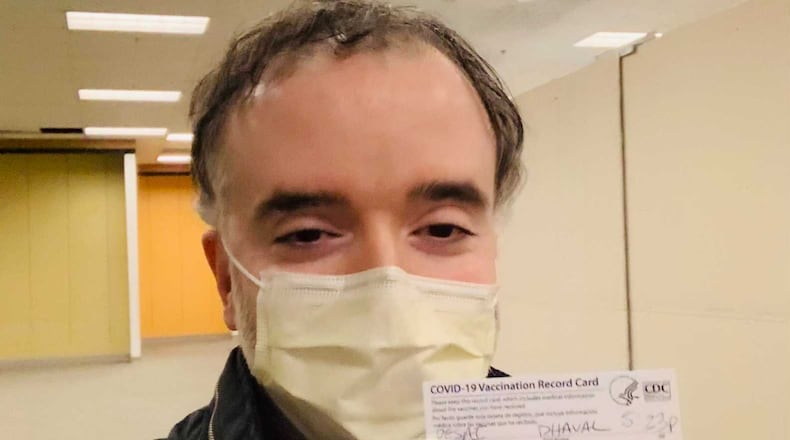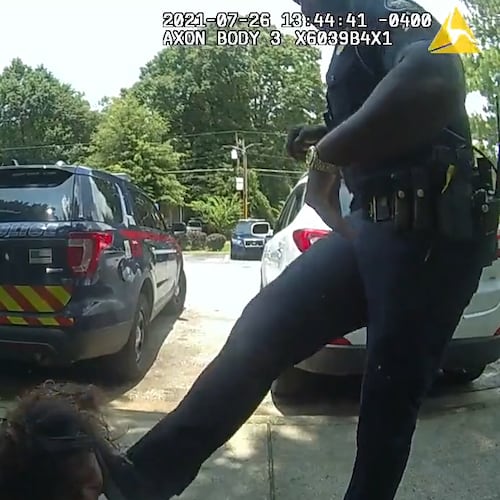Dr. Dhaval Desai, director of hospital medicine at Emory Saint Joseph’s, shares his experience getting one of the first doses of the COVID-19 vaccine in Georgia. This interview was edited for length and clarity.
I felt a lot of excitement building up waiting for my appointment, checking my e-mail constantly. My appointment was at 5 p.m. Thursday, Dec. 17. I drove over to my location to get the vaccine. I felt butterflies; it almost felt like I was at Disney or Six Flags about to get on a thrilling ride. I wasn’t nervous at all. I was excited about moving forward.
I show up for my 5 p.m., and I’m part of a group of 10 people and I see three of my colleagues from different hospitals. I check in; it is all very organized. The staff member asks me which arm and suggests the non-dominant arm, so I go with my left arm, and at 5:08 p.m., I got the shot. I was smiling the whole time. I didn’t feel the needle go in. There was no sensation. It wasn’t cold or warm, I didn’t feel anything. Then the Band-Aid went on, and I sat in a waiting area for 15 minutes to make sure there was no reaction. I felt fine.
I went to my car and called my wife, and there was a lot of excitement. My daughter (who is 4) knew what was happening, and she was very excited, too. ‘Come home daddy!,’ she said. I arrived home about one hour after my shot.
About two hours after the shot, I felt arm soreness. It was nothing unmanageable, and I didn’t need medication. My energy that night was fine. I had no fever. I checked my temperature twice out of curiosity, and it was 97 degrees both times.
It felt good seeing everyone on social media who got the vaccine, and my brother, who is a doctor in another state and had also gotten the COVID-19 vaccine. It felt magical to be a part of it.
I got up at 6 a.m. Friday and still felt soreness in the arm but not any worse. It wasn’t as mild as the flu shot but somewhere between the flu shot and the Tdap vaccine (which is known for causing pain, redness, or swelling at the injection site). But I just thought, ‘I feel sore because I got the COVID-19 vaccine.’
I also had one episode of minor diarrhea in the morning, to be totally transparent.
On Friday evening, I had a mild headache and a few muscle cramps but no fever. I took a dose of ibuprofen (two Advil pills of 200 mg) before going to bed, and slept great. On Saturday, I had mild fatigue when I woke up but it got better throughout the day. I even took my daughter to the zoo for her birthday. By Sunday, the arm soreness was completely gone and I felt normal.
I got a reminder Friday morning from Emory to schedule my second dose, which I did, for Jan. 3.
This is a very challenging time with our third wave and we are very worried about what the next few weeks will look like. Our adrenaline is waning, but we keep showing up and doing what we do and treating patients and getting them out of the hospital. It’s exhausting but, hopefully, this is the last big push and we will see improvements.
This vaccine is giving health care workers a sense of hope that I personally didn’t have before.
Side effects from second shot short-lived
On Monday, January 4th, while driving to the vaccine site, I was reflecting back on a week of a very busy time rounding on COVID patients. I was thinking to myself that the pandemic has to end as we are nearly one year into this! Knowing I was going for my second vaccine to complete the series gave me hope. I got my shot at 1:20 pm. I barely felt the needle go in, and it was very fast. While being observed from my car, I saw familiar nurses and a few acquaintances, and we all celebrated that it was my second dose.
I drove back home, and felt well for the rest of the afternoon-evening. I had no symptoms during first eight to 10 hours. Before I went to bed that night, I had very mild arm soreness and nothing else.
In the middle of the night, around 3 a.m., and about 14 hours after getting my shot, I woke up feeling uncomfortable. I could not pinpoint what was going on. I didn’t have any pain, but felt very restless. About 15 minutes later, I started having chills that progressively got worse. The chills felt deep to the bone, and I knew I was having rigors. I asked my wife to get me an extra blanket, but I still could not get warm. During the rigors, I felt uncomfortable and cold, but was not scared. I knew that this was a common reaction, especially after the second dose, and the second dose is known to cause more side effects.
I knew that what I was experiencing was going to be temporary. The rigors stopped after about 20 minutes, and I checked my temperature where it was 99.2. I slept on and off the rest of the night, and started having a headache and body aches.
Credit: Ben Gray
Credit: Ben Gray
The next morning, I had purposefully scheduled myself to be non-clinical working administratively from home as I knew the second dose could have more side effects. That morning, my temperature was 99.7. I took Tylenol for the general headache and body aches, along with rising temperature. I was still able to work from home, take care of my kids, and get through the day.
The following day, on Jan. 6, the side effects subsided and I felt normal by the evening.
In full transparency, I did not like the side effects of the second dose. And, I knew the side effects that I felt were a result of my immune system reacting to the vaccine and my body was doing what it was supposed to. The side effects were short-lived and very tolerable in comparison to actually getting COVID or having a loved one suffer with it. As a healthcare worker, I hope this is our last major surge, so we can start returning to normalcy.
About the Author
Keep Reading
The Latest
Featured





